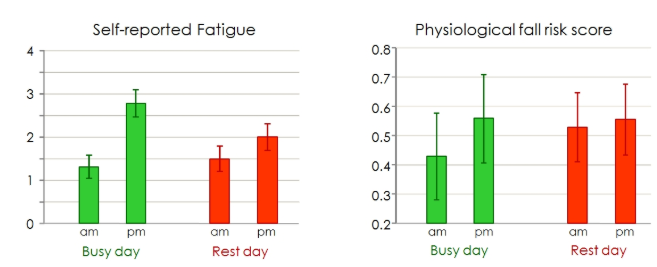Fatigue is a common complaint for older people; more than 50 per cent of people aged 70+ report fatigue in undertaking their daily activities. Laboratory-induced fatigue has been shown to affect sensory and movement functions that are associated with falling, such as strength, balance and limb sensation. In addition, fatigue is likely to affect cognitive functions, such as processing speed and attention, which are essential to maintain balance. Therefore, a busy day of shopping, social activities or minding the grandchildren might leave an older person at risk of falling late in the day.
Previous studies showing fatigue effects have employed rigorous laboratory protocols that are unlikely to accurately reflect an older person’s daily activities. So, we asked a group of 50 healthy older people to plan a busy day (where they tried to fit in as many chores or physical activities as possible) and compared changes in fall-related measures of physical and cognitive function with a planned rest day (in which they tried to avoid activity by relaxing, reading or watching TV etc.). Using activity monitors, we found our participants undertook twice as many steps and 2.5 times more minutes of activity on the busy day, compared with the rest day. Participants reported an increase in feelings of fatigue following the busy day and no change in fatigue following the rest day (see figure). However, performance on physical and cognitive tests associated with fall risk changed similarly across the busy and rest days, suggesting that a busy day has little effect on factors associated with fall risk in older people.

Figure: Group mean (SD) self-reported fatigue and physiological fall risk score in the morning (am) and afternoon (pm) of the busy and rest days.
Our busy day protocol did not result in reduced strength, balance and stepping performance in older people, which is different from studies of immediate fatigue conducted with arduous fatiguing protocols in laboratory settings, but similar to studies of physical activity that increased reported tiredness. If any detrimental effects of increased activities undertaken during the busy day occurred, they were not long lasting and had dissipated by the time that the afternoon assessments were undertaken (approx. 4pm). Overall, the findings suggest that in the afternoon of a busy day (based on older people’s estimates of their busiest days), cognitive and physical functions associated with fall risk are minimally affected in healthy older people.
Publication
Sturnieks DL, Yak SL, Ratanapongleka M, Lord SR, Menant JC. A busy day has minimal effect on factors associated with falls in older people: An ecological randomised crossover trial. Exp Gerontol. 2018 12;106:192-197.
About the Author

Daina Sturnieks
Falls, Balance and Injury Research Centre at Neuroscience Research Australia, Sydney
Daina Sturnieks is a Research Fellow in the Falls, Balance and Injury Research Centre at Neuroscience Research Australia, Sydney. Her research focuses on understanding sensorimotor and neurocognitive contributions to falls in older people and clinical groups, and trialling novel interventions to prevent falls with balance, stepping and cognitive exercises.
Copyright
© 2018 by the author. Except as otherwise noted, the ISPGR blog, including its text and figures, is licensed under a Creative Commons Attribution-ShareAlike 4.0 International License. To view a copy of this license, visit https://creativecommons.org/licenses/by-sa/4.0/legalcode.
ISPGR blog (ISSN 2561-4703)
Are you interested in writing a blog post for the ISPGR website? If so, please email the ISGPR Secretariat with the following information:
- First and Last Name
- Institution/Affiliation
- Paper you will be referencing
